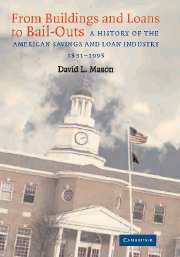 From Buildings and Loans to Bail-Outs
From Buildings and Loans to Bail-Outs Book contents
- Frontmatter
- Contents
- List of Tables
- Acknowledgments
- Introduction
- 1 A Movement Takes Shape, 1831–1899
- 2 The Rise of the League, 1900–1929
- 3 From State to Federal Oversight
- 4 The Movement Becomes an Industry, 1930–1945
- 5 The Glory Years, 1946–1955
- 6 External Challenges and Internal Divisions, 1956–1966
- 7 Lost Opportunities, 1967–1979
- 8 Deregulation and Disaster, 1979–1988
- 9 Resolving the Crisis, Restoring the Confidence, 1989–1995
- 10 The American Savings and Loan Industry in Perspective
- Appendices
- Bibliography
- Index
10 - The American Savings and Loan Industry in Perspective
Published online by Cambridge University Press: 29 October 2009
- Frontmatter
- Contents
- List of Tables
- Acknowledgments
- Introduction
- 1 A Movement Takes Shape, 1831–1899
- 2 The Rise of the League, 1900–1929
- 3 From State to Federal Oversight
- 4 The Movement Becomes an Industry, 1930–1945
- 5 The Glory Years, 1946–1955
- 6 External Challenges and Internal Divisions, 1956–1966
- 7 Lost Opportunities, 1967–1979
- 8 Deregulation and Disaster, 1979–1988
- 9 Resolving the Crisis, Restoring the Confidence, 1989–1995
- 10 The American Savings and Loan Industry in Perspective
- Appendices
- Bibliography
- Index
Summary
The history of the American savings and loan industry from 1831 to 1994 is essentially a story of how local institutions helped millions of American families acquire homes and save for the future. From the start, S&Ls achieved these goals by requiring thrift members to adhere to the basic principles of mutual cooperation and systematic savings. Because these nascent institutions were easy to organize and used relatively simple operating procedures, S&Ls were especially popular with working-class men and women who joined them in order to improve their lives financially. This idea of self-improvement was echoed by industry leaders who portrayed S&Ls as being part of a broader social movement. By the end of the nineteenth century, S&Ls had become so numerous that they formed trade organizations, first at the state and local levels, later at the national level. The thrift business prospered in the early twentieth century, but like most financial sectors suffered serious losses during the Great Depression. Even in the 1930s, though, some progress occurred as Congress enacted the first federal thrift regulations. The high point for the S&L industry came after World War II, when the demand for housing resulted in strong expansion and enhanced profitability. In the 1960s and 1970s, however, increasing divisions within the thrift industry, combined with growing economic uncertainties and new sources of competition, fueled an effort toward deregulation in the 1980s.
- Type
- Chapter
- Information
- From Buildings and Loans to Bail-OutsA History of the American Savings and Loan Industry, 1831–1995, pp. 266 - 274Publisher: Cambridge University PressPrint publication year: 2004


